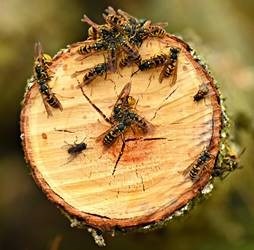The most familiar wasps we encounter live in large cooperative nests, like bald-faced hornets, yellowjackets and other wasps, yet the majority of wasp species are solitary and focused only on their own offspring. But for the majority of wasps we encounter, the spring process begins with a fertilized wasp queen arising from hibernation and begins a nest by producing worker wasps - of which are all females. The wasp workforce continue to grow the size of the nest by breaking down the walls and rebuilding larger new walls while the queen continues to lays more eggs. In late summer the queen will lay male and queen eggs. By the fall, thousands of wasps begin to die of except for the newly fertilized queens that find a place to shelter for hibernation until the following spring where the process begins again. Interestingly, bee venom is acidic and wasp venom is alkaline, so people will respond differently to their stings; people that have anaphylactic reactions to one and not to the other. Wasps and bees produce an attack pheromone that causes an attack frenzy, what ever the pheromone is on may get repeated stung. Solitary wasps only sting when manually provoked and their venom typically causes only short-lived pain.
Go Green Pest Control owner Randy Bilesky is a long-time South Delta resident. Trained and certified, Bilesky has first-hand knowledge of the pest problems that local homeowners and business owners encounter.


